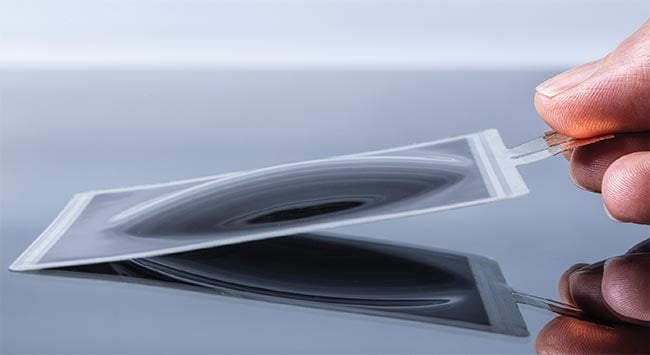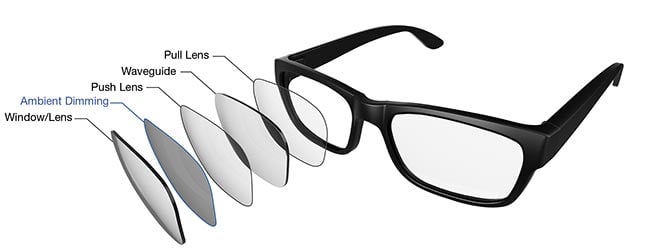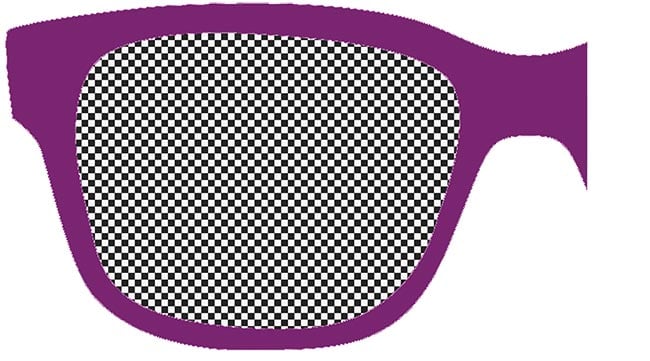PAUL CAIN, FLEXENABLE
Visibility is critical when it comes to developing see-through augmented reality (AR) optics. Users must be able to clearly see the real world in harmony with the superimposed virtual one on their smart glasses. These two elements of the view should be
balanced, with one almost indistinguishable from the other.
Arguably one of the biggest hurdles to achieving this is the constant change of real-world environments and lighting
conditions that users will encounter, especially when considering long-term wear. Even the simple act of moving from one room to another will introduce a whole new set of variables, making it more difficult to balance the virtual image against the real world. If a headset is used in a completely dark room, then it will be easy to see a virtual image projected by a light engine and associated optics. The same is also likely to be true in a typical office environment.

A biaxially curved liquid crystal dimming cell enables dimming films to fit snugly against other curved optical surfaces. Courtesy of FlexEnable.
However, in much brighter ambient
conditions, it can be difficult to see virtual objects in front of the real world; they may appear washed out (low contrast) with darker colors that are almost impossible to reproduce correctly. This happens because the light engine can only add photons on top of the view of the real world — it cannot subtract them. Increasing the brightness of the image is one way to improve this contrast issue with smart glasses. But, this cannot compensate for darker colors and hinders the device’s battery life and generates uncomfortable heat from power consumption — already a major constraint for untethered headsets.
AR device manufacturers are using technology to tackle this from the other side: Their aim is to darken the real world by controlling the amount of ambient light passing through the lenses. This enhances the visibility of virtual images in all environments and can even give them a sense of “solidness” as they reduce the observed luminance of real-world objects.
Types of dimming
Global dimming is the simplest approach to control the external light sources, dimming the real world by the same degree at the same time, much like a pair of light-sensitive sunglasses. This allows virtual objects to be seen more clearly with higher contrast, because the dimming only affects the real world and not the virtual object. Another use of this dimming technology, if it can dim sufficiently, is to allow the AR headset to be used in a virtual reality (VR) mode, in which the user’s view of the real world is removed, for example, when static video content is viewed in a sort of virtual cinema.
While global dimming can be useful, there may be situations in which one must see the virtual object clearly, without compromising and/or dimming the view of the real world. An example occurs when one is guided by an AR headset during work, where both the real-world and virtual instructions must be clear and uncompromised. Another example takes place in precision tasks such as surgery, during which high luminance is required to “stop down” the human eye, decreasing the pupil size to increase depth of focus.
Another approach, pixelated dimming, divides the same dimming area into an array of pixels, each individually controllable in its level of dimming, essentially a grid of miniature “shutters.” The advantage of pixelated dimming is that it allows much more granular control over real-world lighting levels by dimming only the specific pixels “behind” virtual objects.


Designers benefit from flexible liquid crystal cells as new form factors become a reality, due to curvable dimming cells (top).
Pixelated dimming divides a set dimming area into an array of pixels (bottom). The lens provides an example of pixelation. Courtesy of FlexEnable.
In this approach, the size of these dimming pixels does not need to be as small as the pixels that form the virtual image (from the light engine). Indeed, there would be no point: Eyes are unable to focus on these dimming pixels.
Instead, the dimming pixels are intended to provide dark zones on which the high-resolution virtual image can be overlaid. An important requirement for spatial dimming is that the dimming levels on each pixel must be rapidly adjusted, because any movement of the head would require the dimming zones as well as the virtual image to be repositioned in the field of view.
Dimming technologies
Several dimming technologies exist, some suited to both global and pixelated dimming, others only suited to global dimming.
One approach is to use the same dimming technologies used in liquid crystal displays (LCDs); an LCD is effectively a dimmer with a backlight behind it. This provides the advantages of being highly optimized for performance, and with an established, robust supply chain. The primary drawback is its limited transmission: Because the LCD mechanism requires polarizers, then at least half of the light is lost. The maximum transmission possible is typically <45%. This may be undesirable or even unacceptable in dimly lit environments.
A second approach is to use electrochromic dimming, whereby a material undergoes a reversible chemical reaction under an applied voltage, resulting in a color change. This has the advantage of not requiring polarizers (higher transmission) as well as bistability. However, it is inherently a slow switching process, occurring in seconds or longer. As such, it can be used for only global and not pixelated dimming.
Dimming is just one of many areas in which optical performance is improving, yet all these performance enhancements must be achieved and incorporated while continuing to reduce the size and weight of headsets.
A third approach is to use a different kind of liquid crystal that does not require polarizers, known as dye-doped guest-host liquid crystals (GHLCs). These have a dye mixed in with the liquid crystal, and the dye has very different absorption properties in different directions. When the liquid crystal molecules change orientation under applied voltage, they cause the dye to also change orientation, and therefore change the level of dimming seen through the film. This polarizer-free approach can therefore have a high transmission (e.g., 80%) but switches up to 1000× faster than electrochromic
(i.e., 10 ms) and is color neutral.
Importantly, among the three approaches only GHLCs can achieve the transmission and switching speeds that are needed for high-transmission pixelated dimming. Still, all three variants are likely to be used in devices, at least in the short term, depending on initial product requirements.
Commercial integrated dimming devices
The location of dimming modules within the optical system in a headset depends on the product’s optical architecture and the type of dimmer used. In certain cases, it may be laminated directly to a lens, and in others, it may sit farther back in the stack, for example, on the outer visor. This is dependent on the mechanical and optical properties of the dimmer. To produce a final product that is more like traditional glasses, any dimming must be tightly integrated and conformed to existing surfaces to minimize volume.
The first generation of products with dimming capabilities arrived on the
market by 2022, targeting both consumer and enterprise customers. The Air 2 Pro and Ultra AR glasses, from XREAL, feature global electrochromic dimming to three preset levels. This tints the entire field of view and is controlled by the user through a physical button on the side of the device. Similarly, Viture’s One XR glasses also include global dimming controlled by a physical button. And Magic Leap’s Magic Leap 2 can perform both global and pixelated dimming, where the application determines the amount and type of dimming employed. The responses to dimming advancements for see-through AR have been very positive, and this technology is now considered a must-have for future iterations.
While some headsets will initially incorporate global dimming, many now expect pixelated dimming to be needed for optimal performance. Dimming is just one of many areas in which optical performance is improving, yet all these performance enhancements must be achieved and incorporated while continuing to reduce the size and weight of headsets. They must resemble a regular pair of glasses to ensure that they are comfortable, appealing to wear, and functional for all-day use. This requires additional optics to be not only thin and light but also ideally shaped to conform to commonly curved fixed optical surfaces in the headset to minimize volume.
Flexible cells for next-generation AR
Future generations of AR glasses will aim to be indistinguishable from a pair of ordinary vision-correction glasses. For dimming, this means future technology must adhere to a set of standards. The tech must first be extremely thin and lightweight as well as curved to match the surfaces of fixed optics. The screens will be pixelated to greatly enhance the visual experience. There must be high transmission, with low haze, so that the environment is clearly visible. And the technology must be fast-switching and low-power to cope with dynamic and demanding applications.
This means that cells must be built on plastic films instead of glass to meet these size and flexibility requirements. This is more easily completed for global dimmers, but to be pixelated, transistors must be included to control the individual pixels. Finally, to become high-transmission and fast-switching while also being low-power, dye-doped GHLC modes are needed.
Building pixelated dimmers on plastic requires transistors to be manufactured directly onto optically clear plastic films with well-controlled optical properties suitable for use with liquid crystals.

No Dimming
The zebra is barely visible against
the bright background, and the dark
regions appear transparent. |
Global Dimming
With the background luminance
reduced, the zebra is more clearly
visible, but the real-world view
is compromised. |
Pixelated Dimming
The zebra is clearly visible with no
compromise to the real-world view;
the zebra’s black stripes appear darker
than for the global dimming case,
because the eye is “light adjusted.” |
Pixelated dimming, one of three types of dimming, allows much more granular control over real-world lighting levels by dimming only the specific pixels ‘behind’ virtual objects. Courtesy of FlexEnable.
This is where organic transistors come into play. Organic thin-film transistors (OTFTs) use a class of organic semiconductor materials in place of silicon. While organic transistors are well-known for their flexibility, it is less well-known that the manufacturing process to make these transistors is undertaken at much lower temperatures than that which silicon requires: <100 °C, compared with >300 °C
for silicon. This is fundamental to the ability to build transistors directly onto optically ideal plastics without damaging the flexible film.
Further, the same manufacturing techniques that can be used to build OTFTs can also be used to fabricate complete
liquid crystal cells on ultrathin plastic
films. Using triacetyl cellulose, a recyclable, biodegradable plastic with excellent optical properties, has proved to be effective for this fabrication. This film is widely available and usually supplied with a thickness of only a few tens of microns, meaning complete dimming cells can be as little as 100-µm thick, making their weight only a fraction of a gram.
Also, because of their thinness and the low temperature properties of the substrate, the dimming films can be 3D (biaxially) curved. This enables them to fit snugly against other curved optical surfaces, minimizing the volume of a device. This combination makes pixelated liquid crystal cells far simpler to integrate into optical stacks and devices that
approach the look of regular glasses.
Looking ahead, designers will benefit from flexible liquid crystal cells as new form factors become a possibility due to curvable dimming cells that can be more easily integrated without compromising design. Manufacturers will be able to produce lightweight, comfortable devices. And for their part, developers will be able to take advantage of high-resolution, fast-switching dimmers, providing for experiences far in advance of current models of smart glasses.
As for customers and end users, both will benefit from the cumulative effects of these advantages with the ability to use all-day wearable devices that seamlessly blend into their everyday lives.